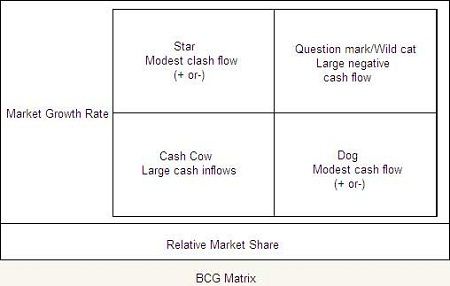BCG Matrix is a simple tool. This tool is mostly used to understand and analyze business units and product lines. It was developed by Brucy Henderson of Boston Consulting Group. It is a powerful tool which can be used for resource allocation decisions in strategic management. Given below is a figure that represents the basic contours of a BCG matrix. This tool places business units/products/brands within four quadrants, based on their relative market share and market growth.

The names of the quadrants are ‘Star’, ‘Question Mark’, ‘Cash Cow’ and ‘Dog’. Each quadrant represents some unique characteristics. These are given below:
- Star-these are units in fast growing industries and have large market share. They require cash for growth as they are net balanced in cash flows. It is hoped that they would become cash cows.
- Cash cows-these are units in a slow growing industry but have large market share. They are cash flow positive and are considered to be great assets. Investment required in such units is low but output of these units in terms of profits and cash flow is high.
- Dogs-these are the units in a slow growing industry that also have low market share. They break-even and are ideal candidates for being sold off. They are considered to be poor assets.
- Question mark-these are units which though in growing markets have low market share. They consume a large amount of cash for expansion and are typically not in a position to generate large cash flows. Hence, they are cash negative. They can become dogs and hence the companies should either invest heavily in such units or sell them off.
 Dinesh Thakur holds an B.C.A, MCDBA, MCSD certifications. Dinesh authors the hugely popular
Dinesh Thakur holds an B.C.A, MCDBA, MCSD certifications. Dinesh authors the hugely popular